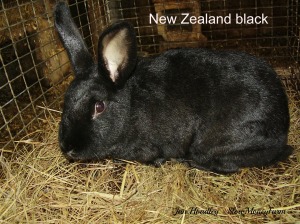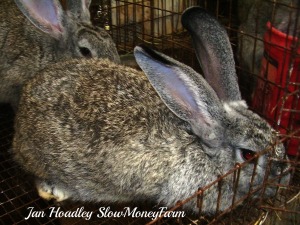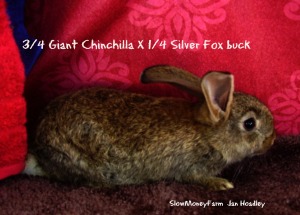 When selecting rabbit breeds to feed a family the individual must always be considered. There is good and bad in many breeds or they would not still be in existence. The breeds for commercial raising are limited because of the demand for white fryers and a penalty for colored furs; this eliminates all but a very few breeds. However, as a homesteader you are not bound by this because it is you that will use the meat and, hopefully, make use of the pelt as well so as to not waste what is provided.
When selecting rabbit breeds to feed a family the individual must always be considered. There is good and bad in many breeds or they would not still be in existence. The breeds for commercial raising are limited because of the demand for white fryers and a penalty for colored furs; this eliminates all but a very few breeds. However, as a homesteader you are not bound by this because it is you that will use the meat and, hopefully, make use of the pelt as well so as to not waste what is provided.
When you are looking for home food production these rabbits can also be good for showing as well as, for many, pets. Because for efficient production of meat they should be 5-6 pounds by 4-5 months it eliminates the small breeds. The dominance here is the larger 8 pound plus mature animals that have decent sized litters, raise them without a great deal of pampering and for those who are unsuited for show or breeding, provide a family with clean, low cost meat for the freezer. As long as there are hungry people there’s no reason for “overpopulation” of rabbits. Additionally, by using them for meat it guarantees they won’t be mistreated or turned loose to fend for themselves by placing in a poor pet home.
REX were developed for meat and fur production. They have a soft, plush fur that makes it ideal for crafts as well as for shawls or other products you can make at home. The Rex is typically 8-10 pounds at maturity and with good feed can produce a litter six times per year. This takes top management breeding her, when the kits are a month old rebreeding her. At 5-6 weeks she is removed from the litter so she has 2-3 weeks to rest before the next litter is due. A good homestead rabbit should be able to maintain this with a minimum of issues providing *good* management is given! Rex are normally easy going rabbits and come in a wide range of colors from the recently accepted amber to blue and broken (or spotted) patterns. More recently the otter has been expanded from just black to include blue, chocolate and lilac colors.
AMERICAN CHINCHILLA Developed in America for food and fur this normal’ furred rabbit has a deserved reputation as a good mother. With a 9-11 adult weight she can produce 5 pound fryer rabbits by the time they are just a few months old. The beautiful color of the chinchilla breeds is actually developed with rings of color on each hair, visible when you lightly blow into the fur. The disadvantage to this beautiful breed is they are critically rare so it can take some effort to find them. They still do well what they have done for nearly 100 years produce a family with food.
NEW ZEALAND Long considered THE meat rabbit the white variety is the most common rabbit in the 8-10 or so pound size. If you see a normal fur white rabbit chances are it’s New Zealand. Less common is the red and black New Zealand with blue and broken black being developed for those who aren’t commercial and want more than white fur. From a commercial standpoint the white fur takes dye the best, but from a home-raised standpoint artificial dyes don’t compete with natural colors.
 GIANT CHINCHILLA This is a large breed of up to 16 pounds with the chinchilla coloring, developed for the larger size that can carry more meat on a wide frame. The breed is American made with a docile temperament and good mothering abilities. Like the American Chinchilla they can be hard to find. Although more numerous they are still recovering from low numbers that threatened to make them extinct.
GIANT CHINCHILLA This is a large breed of up to 16 pounds with the chinchilla coloring, developed for the larger size that can carry more meat on a wide frame. The breed is American made with a docile temperament and good mothering abilities. Like the American Chinchilla they can be hard to find. Although more numerous they are still recovering from low numbers that threatened to make them extinct.
SATINS. My experience with Satins was less than satisfactory due to poor breeding ability on the stock, but it remains they’re a large, beautiful fur breed. Like the Rex, a recessive gene alters the coat and once you see a Satin in full bloom you won’t forget it! They have a beautiful natural sheen that sparkles with deep, rich colors to the fur. They are a good sized breed, many say a little more temperamental but this could be certain lines also.
Other breeds that can work include Californians, Americans, Beverens, Sables, Cinnamon, champagne de argent, palominos and many others. Look for those that mature over eight pounds.
Whichever breed you choose get from a good breeder, ideally one who keeps and selects for animals that exceed in situations you have. If you will be raising them in outdoor hutches it makes sense to select rabbits from parents who were raised in that environment.
 Tell the seller what you are looking for if you want to show it’ll mean a little more expense sometimes especially with the more popular breeds. If you want strictly home meat production then seek one that is good for breeding with a family line of good conception, good mothers, 8-10 kits per litter and raising those kits to weaning. A doe that has 7 per litter is a better bet than one that kills every other litter.
Tell the seller what you are looking for if you want to show it’ll mean a little more expense sometimes especially with the more popular breeds. If you want strictly home meat production then seek one that is good for breeding with a family line of good conception, good mothers, 8-10 kits per litter and raising those kits to weaning. A doe that has 7 per litter is a better bet than one that kills every other litter.
With that in mind, you are time and money ahead to cull any animals with bad attitudes, poor mothers and bucks that consistently sire small litters when on a good program. There are some does that become hormonal and when they have babies get defensive. This is different from the animal that bites every time you reach in the cage.
Select and keep what you like. Even if you show, if you like the offspring of a certain rabbit don’t cull just because a couple judges don’t like her. YOU feed and care for her, you pay the feed bill and you have to look at her every day! At the same time give consideration to comments given if you show because this can also help your goal of meat production. While toenails and white spots don’t make a difference the strength of loin, width of shoulders and general width all the way down DO make a difference. If you think from a practical standpoint that is where your meat is the muscle.
Don’t think just because you’re raising for food you can feed low quality feed and get good production. Good quality care and feed is needed for production. Just because a litter is slated for food production doesn’t mean using cheap poor quality feed and little care if you do you may end up disillusioned and with nothing for the freezer. A bag of low quality feed can be $10-12 for 50 pounds; top quality is just a few dollars more.
Good care means good food. Don’t believe the claims rabbit tastes just like chicken either! You will be disappointed. Rabbits are leaner and need to be cooked differently than the higher fat foods we’re used to.
The rabbit is an amazing animal. A good doe on good management can produce over 200 pounds of meat per year in an area of a small storage shed. It’s best to have three or four does and at least two bucks. Focus on quality feed, quality care and production and a rabbit can produce more than you think for your freezer. Treasure them!
